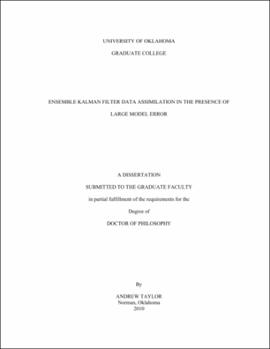| dc.contributor.advisor | Leslie, Lance M||Stensrud, David J | |
| dc.creator | Taylor, Andrew | |
| dc.date.accessioned | 2019-04-27T21:35:16Z | |
| dc.date.available | 2019-04-27T21:35:16Z | |
| dc.date.issued | 2010 | |
| dc.identifier | 9931556802042 | |
| dc.identifier.uri | https://hdl.handle.net/11244/319079 | |
| dc.description.abstract | Though assimilation of synthetically generated surface flux "observations" into numerical forecast models has been attempted, the topic of observed flux data assimilation over land has received little attention. This may be partially due to the lack of available flux observations in most areas. This study examines model analyses and observed data from the summer of 2004. Sensible heat flux estimates are calculated from Oklahoma Mesonet observations of temperature and wind using an iterative profile method reliant on boundary layer similarity theory. These sensible heat flux estimates are assimilated into the MM5 model, coupled with the Noah LSM, using an ensemble Kalman filter (EnKF) data assimilation scheme. A forecast is run over a 48 h period, with EnKF updates to the model grids occurring every hour. A control forecast with no assimilation is also run over the same 48 h period, as well as a forecast including the assimilation of standard surface data from the Oklahoma Mesonet. Results from these three forecasts are compared and contrasted. | |
| dc.description.abstract | It is shown that the EnKF scheme correctly updates the model low level temperature and moisture fields according to the values of the various terms in the governing equations. However, in the case of sensible heat flux data assimilation, model fields are sometimes updated in a way that creates analyses further from observed data rather than closer. Several factors are noted that make assimilation of sensible heat flux a challenge. Large differences between Mesonet estimates of sensible heat flux and horizontally interpolated values from the model can result in changes to the model forecast fields that are far too great. When combined with covariances generated by the model that are not physically based, the problem is amplified. Consistency checks within the EnKF scheme show that the sensible heat flux observation error selected at the beginning of the study may be far too low, and that the ensemble spread is likely not nearly large enough to provide a reasonable estimate of the model error. These issues will need to be addressed before sensible heat flux assimilation can be expected to consistently perform well. | |
| dc.format.extent | 135 pages | |
| dc.format.medium | application.pdf | |
| dc.language | en_US | |
| dc.relation.requires | Adobe Acrobat Reader | |
| dc.subject | Kalman filtering | |
| dc.subject | Heat--Transmission--Measurement | |
| dc.subject | Meteorological stations--Oklahoma | |
| dc.subject | Atmospheric temperature | |
| dc.subject | Weather forecasting | |
| dc.title | Ensemble Kalman Filter Data Assimilation in the Presence of Large Model Error | |
| dc.type | text | |
| dc.type | document | |
| dc.thesis.degree | Ph.D. | |
| ou.group | College of Atmospheric & Geographic Sciences::School of Meteorology | |
